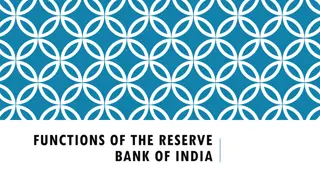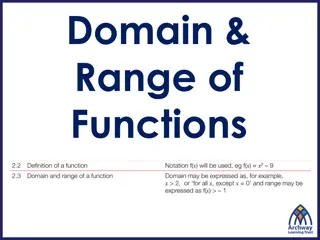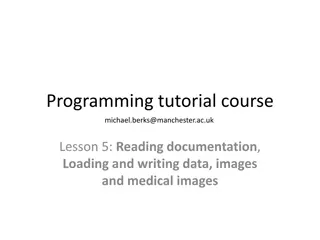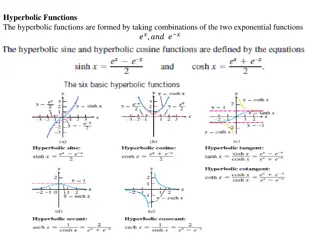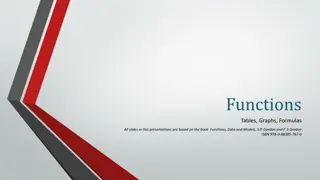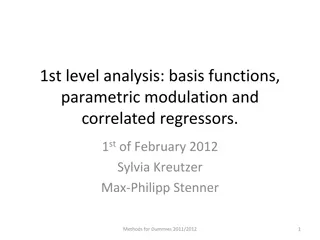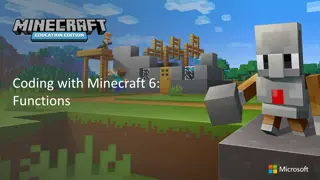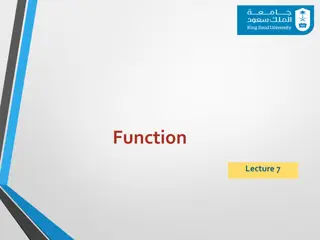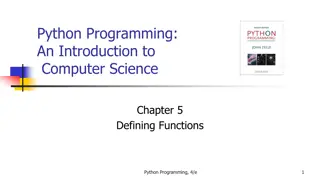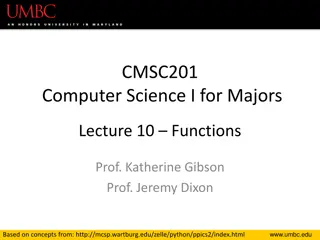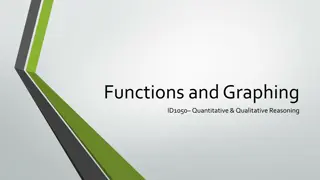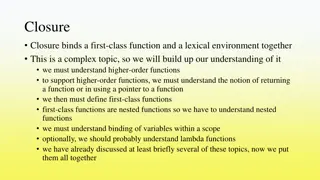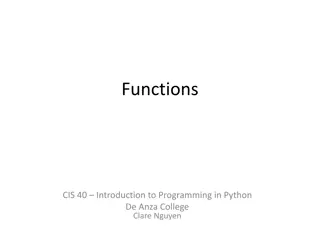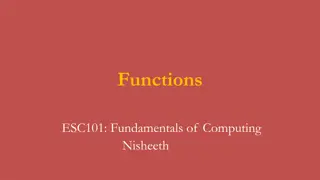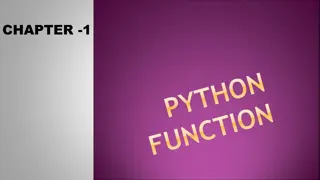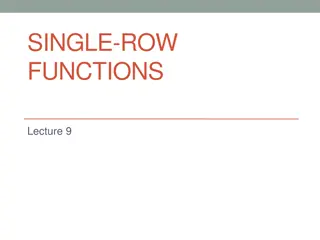C Functions
A function in C is a group of statements that together perform a task. Learn how to define, declare, and call functions in C programming. Understand the importance of return types, function names, parameters, and function bodies. Explore examples like finding the maximum of two numbers and grasp the concept of function declarations. Enhance your programming skills by mastering the use of functions in C.
Download Presentation

Please find below an Image/Link to download the presentation.
The content on the website is provided AS IS for your information and personal use only. It may not be sold, licensed, or shared on other websites without obtaining consent from the author.If you encounter any issues during the download, it is possible that the publisher has removed the file from their server.
You are allowed to download the files provided on this website for personal or commercial use, subject to the condition that they are used lawfully. All files are the property of their respective owners.
The content on the website is provided AS IS for your information and personal use only. It may not be sold, licensed, or shared on other websites without obtaining consent from the author.
E N D
Presentation Transcript
C - Functions A function is a group of statements that together perform a task. Every C program has at least one function, which is main(), and all the most trivial programs can define additional functions. You can divide up your code into separate functions. How you divide up your code among different functions is up to you, but logically the division usually is so each function performs a specific task. A function declaration tells the compiler about a function's name, return function definition provides the actual body of the function. A function is known with various names like a method or a sub-routineora procedure, etc. type, and parameters. A
Defining a Function The general form of a function definition in C programming language is as follows: return_type function_name( parameter list ) { body of the function } A function definition in C programming language consists of a function header and a function body. Hereareall the parts of a function: Return Type: A function may return a value. The return_type is the data type of the value the function returns. Some functions perform the desired operations without returning a value. In this case, the return_type is the keyword void. Function Name: This is the actual name of the function. The function name and the parameter list togetherconstitute the function signature. Parameters: A parameter is like a placeholder. When a function is invoked, you pass a value to the parameter. This value is referred to as actual parameter or argument. The parameter list refers to the type, order, and number of the parameters of a function. Parameters are optional; that is, a function may contain no parameters. Function Body: The function body contains a collection of statements that define what the function does.
Example Following is the source code for a function called max(). This function takes two parameters num1 and num2 and returns the maximum between the two:
Function Declarations A function declaration tells the compiler about a function name and how to call the function. The actual body of the function can be defined separately. A function declaration has the following parts: return_type function_name( parameter list ); For the above defined function max(), following is the function declaration: int max(int num1, int num2); Parameter names are not important in function declaration only their type is required, so following is also valid declaration: int max(int, int); Function declaration is required when you define a function in one source file and you call that function in another file. In such case you should declare the function at the top of the file calling the function.
Calling a Function While creating a C function, you give a definition of what the function has to do. To use a function, you will have to call that function to perform the defined task. When a program calls a function, program control is transferred to the called function. A called function performs defined task and when its return statement is executed or when its function-ending closing brace is reached, it returns program control back to the main program. To call a function, you simply need to pass the required parameters along with function name, and if function returns a value, then you can store returned value.
Example I kept max() function along with main() function and compiled the source code. While running final executable, it would produce the following result:
Recursive Functions A function is called recursive if a statement within the body of a function calls the same function. Sometimes called circulardefinition , recursion is thus the process of defining something in terms of itself. Suppose we want to calculate the factorial value of an integer. As we know, the factorial of a number is the product of all the integers between 1 and that number. For example, 4 factorial is 4 * 3 * 2 * 1. This can also be expressed as 4! = 4 * 3! where ! stands for factorial. However, before we try to write a recursive function for calculating factorial let us take a look at the non-recursive function for calculating the factorial value of an integer.
Ex. Of Non-Recursive Functions #include<stdio.h> int factorial ( int ); void main( ) { int a, fact ; printf ( "\nEnter any number " ) ; scanf ( "%d", &a ) ; fact = factorial ( a ) ; printf ( "Factorial value = %d", fact ) ; } factorial ( int x ) { int f = 1, i ; for ( i = x ; i >= 1 ; i-- ) f = f * i ; return ( f ) ; } And here is the output... Enter any number 3 Factorial value = 6
Ex. Of Recursive Functions #include<stdio.h> int rec ( int x); void main( ) { int a, fact ; printf ( "\nEnter any number " ) ; scanf ( "%d", &a ) ; fact = rec ( a ) ; printf ( "Factorial value = %d", fact ) ; } rec ( int x ) { int f ; if ( x == 1 ) return ( 1 ) ; else f = x * rec ( x - 1 ) ; return ( f ) ; } And here is the output for four runs of the program Enter any number 1 Factorial value = 1 Enter any number 2 Factorial value = 2 Enter any number 3 Factorial value = 6 Enter any number 5 Factorial value = 120
Arrays C programming language provides a data structure called the array, which can store a fixed-size sequential collection of elements of the same type. An array is used to store a collection of data, but it is often more useful to think of an array as a collection of variables of the same type. Instead of declaring individual variables, such as number0, number1, ..., and number99, you declare one array variable such as numbers and use numbers[0], numbers[1], and ..., numbers[99] to represent individual variables. A specific element in an array is accessed by an index. All arrays consist of contiguous memory locations. The lowest address corresponds to the first element and the highest address to the last element.
Declaring Arrays To declare an array in C, a programmer specifies the type of the elements and the number of elements required by an array as follows: type arrayName [ arraySize ]; This is called a The arraySize must be an integer constant greater than zero and type can be any valid C data type. For example, to declare called balance of type double, use this statement: double balance[10]; Now balance is available array which is sufficient to hold upto 10 double numbers. single-dimensional array. a 10-element array
Initializing Arrays You can initialize array in C either one by one or using a single statement as follows: double balance[5] = {1000.0, 2.0, 3.4, 7.0, 50.0}; The number of values between braces { } can not be larger than the number of elements that we declare for the array between square brackets [ ]. Following is an example to assign a single element of the array: If you omit the size of the array, an array just big enough to hold the initialization is created. Therefore, if you write: Following is the pictorial representation of the same array we discussed above:
Accessing Array Elements An element is accessed by indexing the array name. This is done by placing the index of the element within square brackets after the name of the array. For example: double salary = balance[9]; The above statement will take 10th element from the array and assign the value to salary variable. Following is an example which will use all the above mentioned three concepts viz. declaration, assignment and accessing arrays:
Multi-dimensional Arrays in C C programming language allows multidimensional arrays. Here is the general form of a multidimensional array declaration: type name[size1][size2]...[sizeN]; For example, the following declaration creates a three dimensional 5 . 10 . 4 integer array: int threedim[5][10][4];
Two-Dimensional Arrays The simplest form of the multidimensional array is the two-dimensional array. A two-dimensional array is, in essence, a list of one-dimensional arrays. To declare a two-dimensional integer array of size x,y you would write something as follows: type arrayName [ x ][ y ]; Where type can be any valid C data type and arrayName will be a valid C identifier. A two-dimensional array can be think as a table which will have x number of rows and y number of columns. A 2-dimensional array a, which contains three rows and four columns can be shown as below: Thus, every element in array a is identified by an element name of the form a[ i ][ j ], where a is the name of the array, and i and j are the subscripts that uniquely identify each element in a.
Initializing Two-Dimensional Arrays Multidimensional arrays may be initialized by specifying bracketed values for each row. Following is an array with 3 rows and each row has 4 columns. int a[3][4] = { {0, 1, 2, 3} , /* initializers for row indexed by 0 */ {4, 5, 6, 7} , /* initializers for row indexed by 1 */ {8, 9, 10, 11} /* initializers for row indexed by 2 */ }; The nested braces, which indicate the intended row, are optional. The following initialization is equivalent to previous example: int a[3][4] = {0,1,2,3,4,5,6,7,8,9,10,11};
Strings The string in C programming language is actually a one-dimensional array of characters which is terminated by a null character '\0'. Thus a null-terminated string contains the characters that comprise the string followed by a null. The following declaration and initialization create a string consisting of the word "Hello". To hold the null character at the end of the array, the size of the character array containing the string is one more than the number of characters in the word "Hello." char greeting[6] = {'H', 'e', 'l', 'l', 'o', '\0'}; If you follow the rule of array initialization then you can write the above statement as follows: char greeting[] = "Hello"; Following is the memory presentation of above defined string in C/C++: Actually, you do not place the null character at the end of a string constant. The C compiler automatically places the '\0' at the end of the string when it initializes the array. Let us try to print above mentioned string:
Example When the above code is compiled and executed, it produces result something as follows:
String Function & Purpose C supports a wide range of functions that manipulate null- terminated strings: S.N. Function & Purpose 1 strcpy(s1, s2); Copies string s2 into string s1. 2 strcat(s1, s2); Concatenates string s2 onto the end of string s1. 3 strlen(s1); Returns the length of string s1. 4 strcmp(s1, s2); Returns 0 if s1 and s2 are the same; less than 0 if s1<s2; greater than 0 if s1>s2.
Example When the above code is compiled and executed, it produces result something as follows:
MCQs. A function that calls itself is known as a. Inline function c. Overloaded function b. Nested Function d. Recursive function Correct Ans. D Variables declared inside the parenthesis of a function have ___________ visibility a. Local b. Global c. Module Correct Ans. A d. Universal String is an array of character arrays terminated with ____________ a. \n b. \t Correct Ans. C c. \0 d. \1 The void specifier is used if a function does not have return type a. True b. False Correct Ans. A The return type of a function cannot be ___________ a. void b. main Correct Ans. B c. int d. float
MCQs. To accept a string from user, which of the following function is used a. getchar() b. putchar() Correct Ans. C c. gets() d. puts() The strlen( ) function return a ___________ data type value a. string b. float Correct Ans. C c. int d. void The size of an array can be changed during the execution of the program a. True b. False Correct Ans. B The maximum number of dimensions an array can have is ____________ a. 1 b. 2 c. 3 d. None of the above Correct Ans. C Array is a collection of mixed data types a. True b. False Correct Ans. B
MCQs. Find the output of the following program #include<stdio.h> int X=40; void main( ) { int X=20; printf( %d\n ,X); } a. 20 b. 40 Correct Ans. A c. 60 d. Error Find the output of the following program #include<stdio.h> void main( ) { int a[5] = {2,3}; printf( %d%d%d\n ,a[2],a[3],a[4]); } a. Garbage Values Correct Ans. A b. 2,3,3 c. 3.2.2 d. 0,0,0



